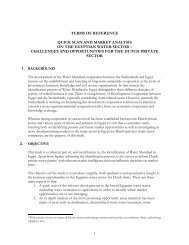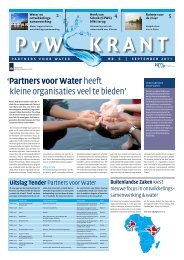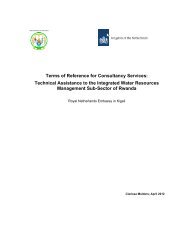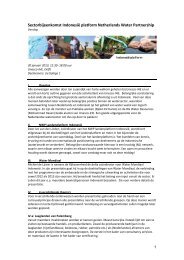Scoping mission on water in rwanda - Partners voor Water
Scoping mission on water in rwanda - Partners voor Water
Scoping mission on water in rwanda - Partners voor Water
Create successful ePaper yourself
Turn your PDF publications into a flip-book with our unique Google optimized e-Paper software.
<str<strong>on</strong>g>Scop<strong>in</strong>g</str<strong>on</strong>g> Missi<strong>on</strong> <strong>on</strong> Rwanda for Embassy of the K<strong>in</strong>gdom of the Netherlands, Kigali<br />
<strong>water</strong> services. EWSA c<strong>on</strong>structs new rural <strong>water</strong> supply <strong>in</strong>frastructure. The Districts own the physical asset<br />
of the rural <strong>water</strong> supplies; management is d<strong>on</strong>e by so-called PPP, a private service provider c<strong>on</strong>tracted by<br />
the District. On the basis of previous experiences, it was c<strong>on</strong>cluded that <strong>water</strong> service management by<br />
community-based <strong>Water</strong> User Associati<strong>on</strong>s did not work satisfactorily; all or nearly all rural <strong>water</strong> service<br />
will be d<strong>on</strong>e through the PPP model. CBOs, c<strong>on</strong>tracted by the PPP, may have a role <strong>in</strong> f<strong>in</strong>al <strong>water</strong> supply<br />
distributi<strong>on</strong> to users.<br />
• Rural and urban sanitati<strong>on</strong>. The situati<strong>on</strong> for sanitati<strong>on</strong> is different and Rwanda is <strong>on</strong> track for the sanitati<strong>on</strong><br />
MDG, quite unique for Africa. The 2008 urban access to improved sanitati<strong>on</strong> is 50% as compared to 35% <strong>in</strong><br />
1990; and for rural these figures are 55% and 22% (JMP, 2008 figures). Urban sanitati<strong>on</strong> is the most critical<br />
part due to high urbanisati<strong>on</strong> and high populati<strong>on</strong> densities. At the recent AfricaSan-3 C<strong>on</strong>ference 4 , the GoR<br />
made a commitment that before the end of 2012, there would be 100% coverage <strong>on</strong> rural improved<br />
sanitati<strong>on</strong>. The much talked-about Open Defecati<strong>on</strong> Free Villages movement is less an issue <strong>in</strong> Rwanda as<br />
98% of rural households has a basic sanitati<strong>on</strong> facility. The sanitati<strong>on</strong> and hygiene improvement approach by<br />
MINISANTE is implemented through the apparently successful Community Hygiene Clubs that address a<br />
spectrum of hygiene <strong>in</strong>terventi<strong>on</strong>s and behaviours.<br />
2.1.4 <strong>Water</strong> for Agriculture (<strong>in</strong>clud<strong>in</strong>g livestock and fisheries)<br />
• The sec<strong>on</strong>d Strategic Plan for Agricultural Transformati<strong>on</strong> (PSTA II) of the M<strong>in</strong>istry of Agriculture and Animal<br />
Resources, developed <strong>in</strong> l<strong>in</strong>e with the Comprehensive African Agricultural Development Programme (CAADP)<br />
of AU-NEPAD, describes the need for rapid agricultural growth. The pressure from high populati<strong>on</strong> density<br />
has left virtually no potential land unoccupied for food producti<strong>on</strong>, except marshlands. Intensificati<strong>on</strong> and<br />
development of susta<strong>in</strong>able producti<strong>on</strong> systems are needed. The way to <strong>in</strong>crease producti<strong>on</strong> addresses the<br />
need for rapid agricultural growth. Development of irrigati<strong>on</strong> is seen as a key <strong>in</strong>strument to reach harvest<br />
security (sub programme 1.4 of PSTA II).<br />
• Irrigati<strong>on</strong> potential <strong>in</strong> Rwanda is 590,000 ha. By mid 2011 some 17,000 ha is under irrigati<strong>on</strong>. The Rwanda<br />
Irrigati<strong>on</strong> Master Plan aims at realiz<strong>in</strong>g 100,000 ha under irrigati<strong>on</strong> by 2017, <strong>in</strong>clud<strong>in</strong>g 65,000 ha of<br />
marshlands. This agricultural development will have an impact <strong>on</strong> the <strong>water</strong> resources sector <strong>in</strong> terms of<br />
quantities used. It also <strong>in</strong>troduces a risk when <strong>in</strong>adequate legislati<strong>on</strong> does not c<strong>on</strong>trol negative effects of<br />
pesticides and nutrients <strong>on</strong> the quality of receiv<strong>in</strong>g surface <strong>water</strong>s.<br />
• Ec<strong>on</strong>omic Growth <strong>in</strong> the Agricultural Sector has more effect <strong>on</strong> poverty reducti<strong>on</strong> than the same level of<br />
growth driven by the n<strong>on</strong>-agricultural sector. Am<strong>on</strong>g agricultural subsectors, growth driven by <strong>in</strong>creased<br />
staple food producti<strong>on</strong> has the greatest poverty reducti<strong>on</strong> effect. One Euro <strong>in</strong>vested <strong>in</strong> agricultural staples<br />
generates 3.84 Euro of <strong>in</strong>creased GDP, much higher then returns <strong>on</strong> <strong>in</strong>vestments <strong>in</strong> export crops. (IFPRI,<br />
2010).<br />
• Rwanda has banned pastoralism. Livestock is therefore c<strong>on</strong>f<strong>in</strong>ed to farms, mak<strong>in</strong>g facilities for <strong>water</strong><strong>in</strong>g the<br />
animals that do not pollute <strong>water</strong> much easier and reduc<strong>in</strong>g the risk of c<strong>on</strong>tam<strong>in</strong>at<strong>in</strong>g <strong>water</strong> sources.<br />
2.1.5 <strong>Water</strong> for Energy<br />
• Rwanda’s electricity produced from hydropower is <strong>in</strong>creas<strong>in</strong>g from 69MW <strong>in</strong> 2009 to 130MW <strong>in</strong> 2012. Other<br />
big schemes under development <strong>in</strong>clude Rusumo Falls (90MW) and Rusizi 3 (147MW), while at a later stage<br />
Rusizi 4 could add almost another 300MW. C<strong>on</strong>structi<strong>on</strong> of Nyagor<strong>on</strong>go 1 is <strong>on</strong>-go<strong>in</strong>g, while the multipurpose<br />
Nyagor<strong>on</strong>go 2 would cater for <strong>water</strong> supply, energy supply and irrigati<strong>on</strong>.<br />
• S<strong>in</strong>ce further development of the Rusizi potential has trans-boundary implicati<strong>on</strong>s, a new bas<strong>in</strong> management<br />
organizati<strong>on</strong> for Kivu and Rusizi has been set up <strong>in</strong> 2011 together with DRC and Burundi and is called<br />
ABAKIR (Autorité du Bass<strong>in</strong> du Lac Kivu et de la Rivière RUSIZI).<br />
4 AfricaSan-3 C<strong>on</strong>ference was held <strong>in</strong> Kigali <strong>on</strong> 19-21 July 2011<br />
Page 6
















